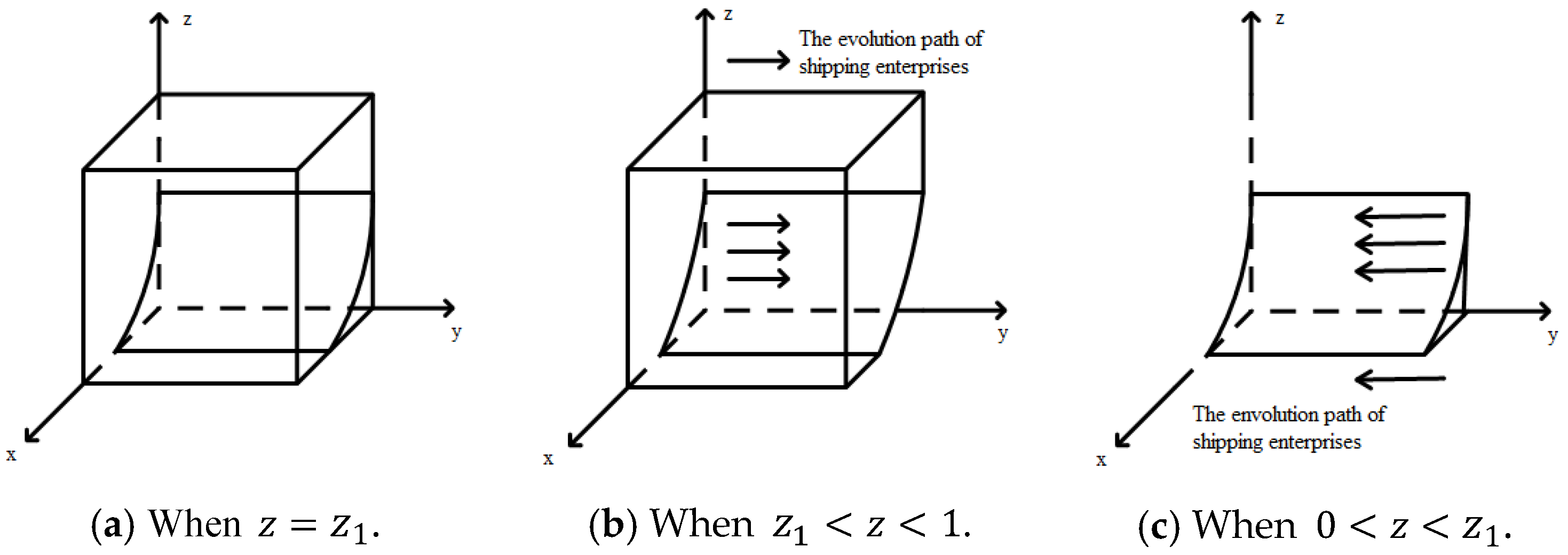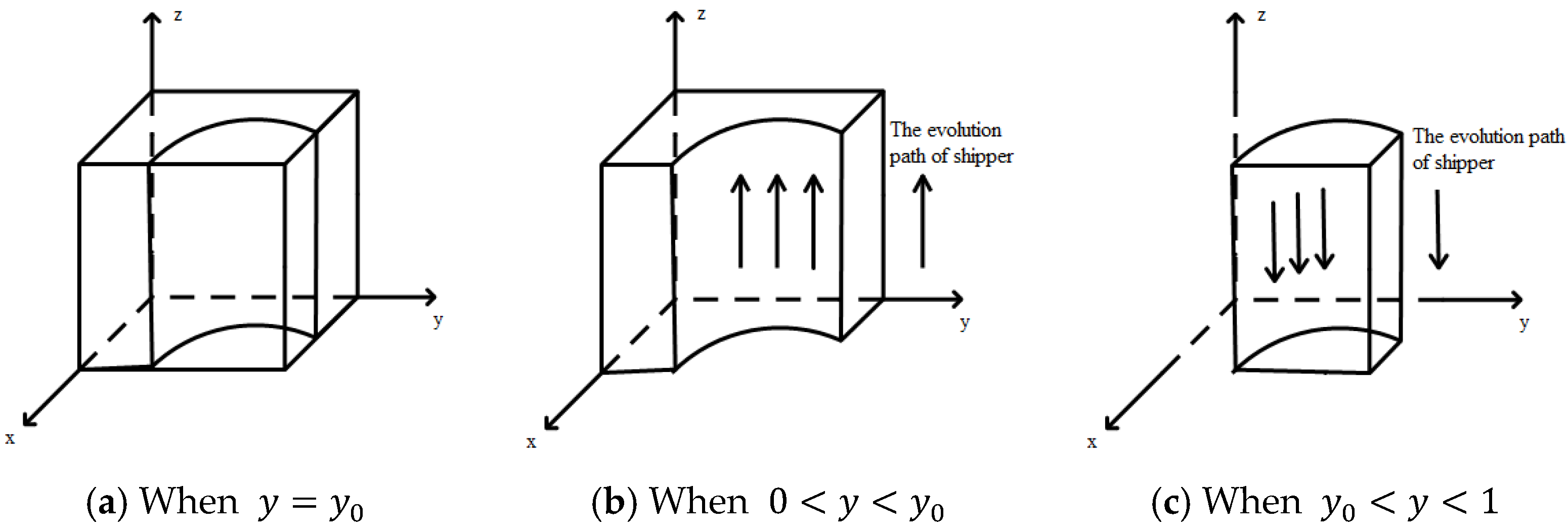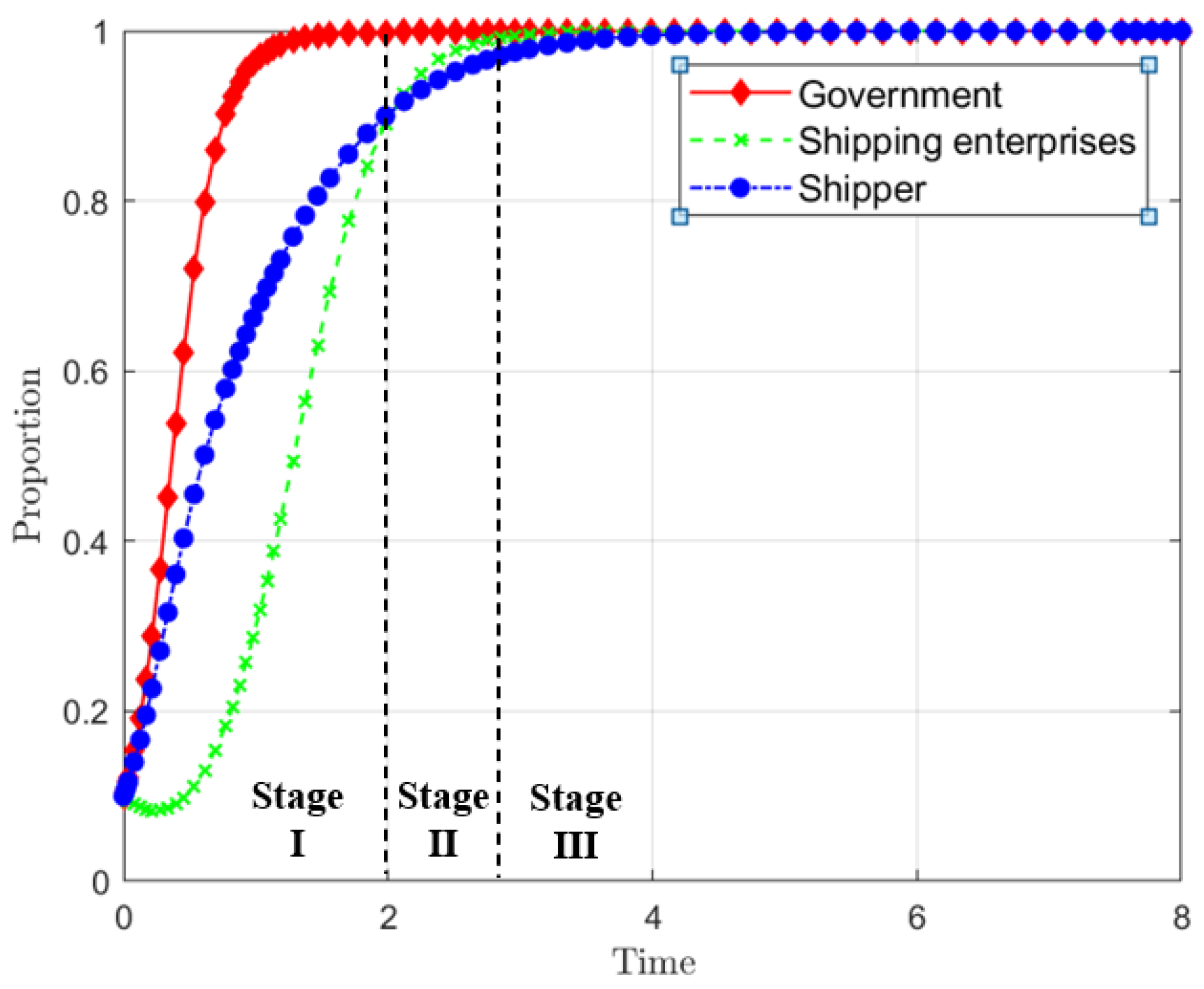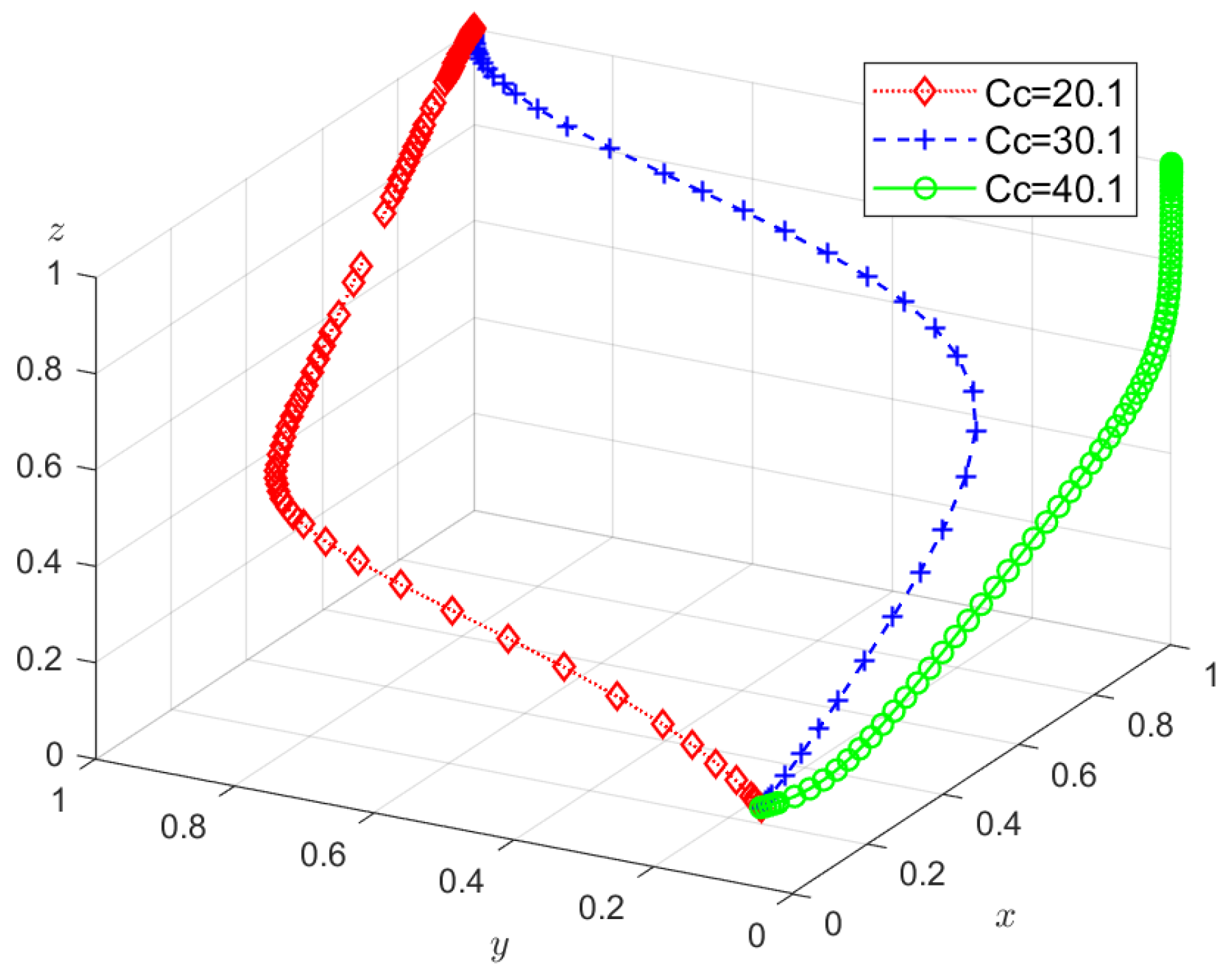A Tripartite Evolutionary Game Study on the Carbon Emission Reduction of Shipping Enterprises Considering Government and Shipper Behavior
Abstract
1. Introduction
2. Literature Review
2.1. Low Carbon Emissions Reduction in Shipping
2.2. Impact of Government and Shippers on Carbon Reduction
2.3. Game Theory from a Low Carbon Perspective
3. The Tripartite Evolutionary Game Model
3.1. Problem Description
3.2. Basic Assumptions and Parameter Settings
3.3. Payoff Matrix Construction
4. Evolutionary Game Analysis
4.1. Replication Dynamic Equations
4.2. Evolution Path Analysis
4.2.1. Analysis of Government Evolutionary Paths
4.2.2. Analysis of Shipping Enterprises Evolutionary Paths
4.2.3. Analysis of Shipper Evolutionary Paths
4.3. System Evolution Equilibrium Analysis
5. Evolutionary Simulation Analysis
5.1. System Evolution Path Analysis
5.2. Impact of Initial Strategies on Evolutionary Stability
5.3. Analysis of the Impact of Single-Factor Changes on System Evolution
5.3.1. Impact of Government Subsidies
5.3.2. The Impact of Government Penalties
5.3.3. The Impact of Cost-Benefit Factors on Shipping Enterprises
5.4. Analysis of the Impact of Multi-Factor Changes on System Evolution
5.4.1. Single Regulatory Mechanism
5.4.2. Mixed Regulatory Mechanism
6. Conclusions and Prospects
6.1. Conclusions
- (1)
- The strategic decisions made by shipping enterprises, governments, and shippers are strongly influenced by the initial probability distributions of the choices made by other stakeholders. Government regulation and shipper supervision play pivotal roles in fostering the commitment of shipping enterprises to reduce emissions. However, increased supervision by shippers diminishes the regulatory pressure on the government, leading to a gradual relaxation of governmental oversight.
- (2)
- The proactive emission reduction strategies of shipping enterprises are driven by a combination of subsidies and penalties. When applied independently, either subsidies or penalties alone result in suboptimal outcomes. However, a hybrid reward-and-penalty mechanism facilitates the attainment of an optimal system equilibrium. The success of shipper supervision is contingent upon the government’s incentives. Insufficient subsidies undermine shipper engagement, thus diminishing the overall effectiveness of emission reductions. Conversely, excessively high subsidy values can impose a heavy financial burden on the government, consequently reducing its enthusiasm for regulation.
- (3)
- Additional emission reduction costs and potential benefits are key factors that influence shipping enterprises’ carbon emission reduction strategies. In the initial stages of the shipping industry’s low-carbon transition, the high costs of technological innovation to allow for low-carbon solutions result in limited motivation regarding emission reduction. Lowering the costs of emission reduction and increasing the revenue linked to emission reduction can incentivize shipping enterprises to adopt proactive carbon reduction strategies.
6.2. Managerial Insights
- (1)
- The government could implement a phased regulatory approach. Initially, it should actively regulate and provide subsidies to incentivize shipping enterprises to invest in emission reduction. As the industry advances in its low-carbon transition, the regulatory strategy should gradually shift towards a market-driven model, placing greater emphasis on shipper supervision and corporate self-regulation.
- (2)
- The government should balance fiscal constraints and regulatory effectiveness by implementing a hybrid incentive policy. This should involve moderate increases in penalties for shipping enterprises, as well as enhanced incentives for shippers to sustain long-term emission reduction efforts. For example, a tiered subsidy-and-penalty system could be adopted to dynamically adjust the intensity of incentives based on actual emission reductions. Furthermore, bolstering financial incentives for shippers can increase their willingness to supervise, thereby encouraging proactive emission reduction from shipping enterprises.
- (3)
- Shipping enterprises may adopt a phased approach. In the short term, they should prioritize the transition to cleaner fuels. Additionally, ship captains ought to familiarize themselves with the emission regulations in target regions, select low-carbon routes, and optimize their sailing speeds. In the long term, shipping enterprises could apply for government subsidies to support technological innovations, such as shore power installations and energy-efficient ship designs, to achieve long-term cost savings.
- (4)
- The government can introduce a green shipping label system, incorporating carbon footprint certification and low-carbon awareness campaigns, to encourage shippers to prioritize low-carbon transportation services, thereby generating demand-driven incentives for shipping enterprises to adopt more sustainable practices.
Author Contributions
Funding
Data Availability Statement
Conflicts of Interest
References
- Kim, H.; Koo, K.Y.; Joung, T.-H. A study on the necessity of integrated evaluation of alternative marine fuels. J. Int. Marit. Safety Environ. Aff. Shipp. 2020, 4, 26–31. [Google Scholar] [CrossRef]
- IMO. Working Group Agrees Guidelines to Support New GHG Measures. 2021. Available online: https://www.imo.org/en/MediaCentre/PressBriefings/pages/ISWG-GHG-8.aspx (accessed on 17 December 2024).
- Li, J.-M.; Jiang, S.-S. How can governance strategies be developed for marine ecological environment pollution caused by sea-using enterprises?—A study based on evolutionary game theory. Ocean Coast. Manag. 2022, 232, 106447. [Google Scholar] [CrossRef]
- Schwartz, H.; Gustafsson, M.; Spohr, J. Emission abatement in shipping–Is it possible to reduce carbon dioxide emissions profitably? J. Clean. Prod. 2020, 254, 120069. [Google Scholar] [CrossRef]
- He, Z.; Wang, D.; Li, J.; Fang, W.; Yang, Y.; Ji, M. An Evolutionary Stability Study of Zero-Carbon Transition for Shipping Enterprises Considering Dynamic Penalty and Carbon Quota Trading Mechanisms. Sustainability 2024, 16, 10684. [Google Scholar] [CrossRef]
- Barreiro, J.; Zaragoza, S.; Diaz-Casas, V. Review of ship energy efficiency. Ocean Eng. 2022, 257, 111594. [Google Scholar] [CrossRef]
- Wang, Z.; Dong, B.; Li, M.; Ji, Y.; Han, F. Configuration of Low-Carbon fuels green marine power systems in diverse ship types and Applications. Energy Convers. Manag. 2024, 302, 118139. [Google Scholar] [CrossRef]
- Bei, Z.; Wang, J.; Li, Y.; Wang, H.; Li, M.; Qian, F.; Xu, W. Challenges and Solutions of Ship Power System Electrification. Energies 2024, 17, 3311. [Google Scholar] [CrossRef]
- Guo, H.; Li, J.; Yang, B.; Mao, X.; Zhou, Q. Green scheduling optimization of ship plane block flow line considering carbon emission and noise. Comput. Ind. Eng. 2020, 148, 106680. [Google Scholar] [CrossRef]
- Tomos, B.A.D.; Stamford, L.; Welfle, A.; Larkin, A. Decarbonising international shipping–A life cycle perspective on alternative fuel options. Energy Convers. Manag. 2023, 299, 117848. [Google Scholar] [CrossRef]
- Wang, Z.; Zhao, F.; Dong, B.; Wang, D.; Ji, Y.; Cai, W.; Han, F. Life cycle framework construction and quantitative assessment for the hydrogen fuelled ships: A case study. Ocean Eng. 2023, 28, 114740. [Google Scholar] [CrossRef]
- Wang, Y.; Iris, Ç. Transition to near-zero emission shipping fleet powered by alternative fuels under uncertainty. Transp. Res. Part D Transp. Environ. 2025, 142, 104689. [Google Scholar] [CrossRef]
- Sun, L.; Ding, P.; Xiong, Y.; Liu, W.; Hu, Z. Carbon emission reduction of shore power from power energy structure in China. Front. Mar. Sci. 2022, 9, 1077289. [Google Scholar] [CrossRef]
- Xue, Y.; Lai, K.-H.; Wang, C. How to invest decarbonization technology in shipping operations? Evidence from a game-theoretic investigation. Ocean Coast. Manag. 2024, 251, 107076. [Google Scholar] [CrossRef]
- Sun, L.; Wang, X.; Lu, Y.; Hu, Z. Assessment of ship speed, operational carbon intensity indicator penalty and charterer profit of time charter ships. Heliyon 2023, 9, e20719. [Google Scholar] [CrossRef]
- Lan, X.; Tao, Q.; Wu, X. Liner-Shipping Network Design with Emission Control Areas: A Real Case Study. Sustainability 2023, 15, 3734. [Google Scholar] [CrossRef]
- Venturini, G.; Iris, Ç.; Kontovas, C.A.; Larsen, A. The multi-port berth allocation problem with speed optimization and emission considerations. Transp. Res. Part D Transp. Environ. 2017, 54, 142–159. [Google Scholar] [CrossRef]
- Gao, X.; Zhu, A.; Yu, Q. Exploring the Carbon Abatement Strategies in Shipping Using System Dynamics Approach. Sustainability 2023, 15, 13907. [Google Scholar] [CrossRef]
- Lin, B.; Huang, C. Analysis of emission reduction effects of carbon trading: Market mechanism or government intervention? Sustain. Prod. Consum. 2022, 33, 28–37. [Google Scholar] [CrossRef]
- Wang, T.; Wang, X.; Meng, Q. Joint berth allocation and quay crane assignment under different carbon taxation policies. Transp. Res. Part B Methodol. 2018, 117, 18–36. [Google Scholar] [CrossRef]
- Herdzik, J. Decarbonization of Marine Fuels—The Future of Shipping. Energies 2021, 14, 4311. [Google Scholar] [CrossRef]
- Zhang, Q.; Chen, C.; Zheng, J.; Chen, L. Quantitative evaluation of China’s shipping decarbonization policies: The PMC-Index approach. Front. Mar. Sci. 2023, 10, 1119663. [Google Scholar] [CrossRef]
- Ye, J.; Chen, J.; Shi, J.; Jiang, X.; Zhou, S. Novel synergy mechanism for carbon emissions abatement in shipping decarbonization. Transp. Res. Part D Transp. Environ. 2024, 127, 104059. [Google Scholar] [CrossRef]
- Li, M.; Luan, J.; Li, X.; Jia, P. An Analysis of the Impact of Government Subsidies on Emission Reduction Technology Investment Strategies in Low-Carbon Port Operations. Systems 2024, 12, 134. [Google Scholar] [CrossRef]
- Li, S.; Dong, C.; Yang, L.; Gao, X.; Wei, W.; Zhao, M.; Xia, W. Research on Evolutionary Game Strategy Selection and Simulation Research of Carbon Emission Reduction of Government and Enterprises under the “Dual Carbon” Goal. Sustainability 2022, 14, 12647. [Google Scholar] [CrossRef]
- Huang, X.; Liu, G.; Zheng, P. Dynamic analysis of a low-carbon maritime supply chain considering government policies and social preferences. Ocean Coast. Manag. 2023, 239, 106564. [Google Scholar] [CrossRef]
- Zhou, H.; Zhang, W. Choice of Emission Control Technology in Port Areas with Customers’ Low-Carbon Preference. Sustainability 2022, 14, 13816. [Google Scholar] [CrossRef]
- McKinnon, A. The possible influence of the shipper on carbon emissions from deep-sea container supply chains: An empirical analysis. Marit. Econ. Logist. 2014, 16, 1–19. [Google Scholar] [CrossRef]
- Chen, J.; Xiong, W.; Xu, L.; Di, Z. Evolutionary game analysis on supply side of the implement shore-to-ship electricity. Ocean Coast. Manag. 2021, 215, 105926. [Google Scholar] [CrossRef]
- Xu, L.; Di, Z.; Chen, J. Evolutionary game of inland shipping pollution control under government co-supervision. Mar. Pollut. Bull. 2021, 171, 112730. [Google Scholar] [CrossRef]
- Zhang, S.; Feng, C. Evolutionary game model for decarbonization of shipping under green shipping corridor. Int. J. Low-Carbon Technol. 2024, 19, 2502–2511. [Google Scholar] [CrossRef]
- Wu, X.; Liu, P.; Wei, Q. Analysis on Evolutionary Stability Strategies of Carbon Emission of Logistics Enterprises Based on Carbon Tax. Math. Probl. Eng. 2021, 2021, 9941243. [Google Scholar] [CrossRef]
- Xiao, G.; Cui, W. Evolutionary game between government and shipping enterprises based on shipping cycle and carbon quota. Front. Mar. Sci. 2023, 10, 1132174. [Google Scholar] [CrossRef]
- Meng, L.; Liu, K.; He, J.; Han, C.; Liu, P. Carbon emission reduction behavior strategies in the shipping industry under government regulation: A tripartite evolutionary game analysis. J. Clean. Prod. 2022, 378, 134556. [Google Scholar] [CrossRef]
- Zhang, S.; Zhang, W. A four-party evolutionary game analysis of carbon emission reduction behavioral strategies in the shipping industry. International J. Low-Carbon Technol. 2024, 19, 1561–1578. [Google Scholar] [CrossRef]
- Li, X.; Kuang, H.; He, H. Research on the Evolution Game of Emission Reduction in Port and Shipping Systems under Government Environmental Regulations. Transp. Syst. Eng. Inf. 2023, 23, 17–29. [Google Scholar] [CrossRef]
- Liang, J.; Zhang, L.; Dou, Y. Evolutionary game analysis of emission reduction strategies between port and shipping enterprises and shippers under carbon trading mechanism. Int. J. Shipp. Transp. Logist. 2024, 19, 505–524. [Google Scholar] [CrossRef]













| Literatures | Analytical Method | Analysis Perspective | Theoretical Contribution |
|---|---|---|---|
| Meng et al. (2022) [34] | Tripartite evolutionary game | This paper analyzes the interaction of carbon emission reduction strategies among the government, port enterprises, and shipping enterprises. |
|
| Xue et al. (2024) [14] | Stackelberg game model | Drawing on mental accounting theory, this paper integrates operational accounts and carbon asset accounts into the model to examine the decarbonization technology investment strategies of ports and shipping companies. |
|
| He et al. (2024) [5] | Bilateral evolutionary game model | This paper analyzes the strategic interactions between governments and shipping enterprises in zero-carbon transition and key influencing factors under the carbon trading mechanism. |
|
| This paper | Tripartite evolutionary game | This paper analyzes the interaction of carbon emission reduction strategies among the government, shipping enterprises and shippers. | See Section 6 |
| Parameter | Definition |
|---|---|
| Enhanced social approval received by local governments during active regulation. | |
| Social welfare benefits generated by shipping enterprises’ proactive emission reduction. | |
| Environmental damage caused by shipping enterprises’ passive emission reduction. | |
| Improved customer evaluation received by shipping enterprises engaging in proactive emission reduction. | |
| Additional regulatory costs incurred by local governments during active regulation. | |
| Additional costs borne by shipping enterprises for engaging in proactive emission reduction. | |
| Costs incurred by shippers for diligently supervising shipping enterprises’ emission reduction. | |
| Rewards from local governments to shipping enterprises for proactive emission reduction. | |
| Rewards from the government to shippers engaging in active supervision. | |
| Rewards from the government to shippers for reporting instances of passive emission reduction behavior by shipping enterprises. | |
| Penalties imposed by the government on shipping enterprises for reported instances of passive emission reduction. | |
| Penalties imposed by local governments on shipping enterprises for passive emission reduction under active regulation. | |
| Additional revenue obtained by shipping enterprises due to proactive emission reduction. | |
| ETS surcharges paid by shippers to shipping enterprises. |
| Government | Shipping Enterprises | Shipper | |
|---|---|---|---|
| Supervision () | Non-Supervision () | ||
| Active regulation () | Proactive emission reduction () | ||
| Passive emission reduction () | |||
| Passive regulation () | Proactive emission reduction () | ||
| Passive emission reduction () | |||
| Equilibrium Point | Eigenvalue | Eigenvalue | Eigenvalue | Symbol | Stability |
|---|---|---|---|---|---|
| (+,*,*) | Unstable fixed | ||||
| (−,*,*) | Uncertain | ||||
| (*,*,*) | Uncertain | ||||
| (*,*,*) | Uncertain | ||||
| (*,*,*) | Uncertain | ||||
| (*,*,*) | Uncertain | ||||
| (*,*,*) | Uncertain | ||||
| (*,*,*) | Uncertain |
| Parameter | |||||||||||
| Value (ten thousand) | 8 | 0.4 | 3.5 | 30.1 | 2 | 3.2 | 3.5 | 4 | 5 | 2.1 | 28 |
Disclaimer/Publisher’s Note: The statements, opinions and data contained in all publications are solely those of the individual author(s) and contributor(s) and not of MDPI and/or the editor(s). MDPI and/or the editor(s) disclaim responsibility for any injury to people or property resulting from any ideas, methods, instructions or products referred to in the content. |
© 2025 by the authors. Licensee MDPI, Basel, Switzerland. This article is an open access article distributed under the terms and conditions of the Creative Commons Attribution (CC BY) license (https://creativecommons.org/licenses/by/4.0/).
Share and Cite
Liang, J.; Dou, Y.; Song, Y. A Tripartite Evolutionary Game Study on the Carbon Emission Reduction of Shipping Enterprises Considering Government and Shipper Behavior. Sustainability 2025, 17, 3895. https://doi.org/10.3390/su17093895
Liang J, Dou Y, Song Y. A Tripartite Evolutionary Game Study on the Carbon Emission Reduction of Shipping Enterprises Considering Government and Shipper Behavior. Sustainability. 2025; 17(9):3895. https://doi.org/10.3390/su17093895
Chicago/Turabian StyleLiang, Jing, Yuying Dou, and Yatong Song. 2025. "A Tripartite Evolutionary Game Study on the Carbon Emission Reduction of Shipping Enterprises Considering Government and Shipper Behavior" Sustainability 17, no. 9: 3895. https://doi.org/10.3390/su17093895
APA StyleLiang, J., Dou, Y., & Song, Y. (2025). A Tripartite Evolutionary Game Study on the Carbon Emission Reduction of Shipping Enterprises Considering Government and Shipper Behavior. Sustainability, 17(9), 3895. https://doi.org/10.3390/su17093895






